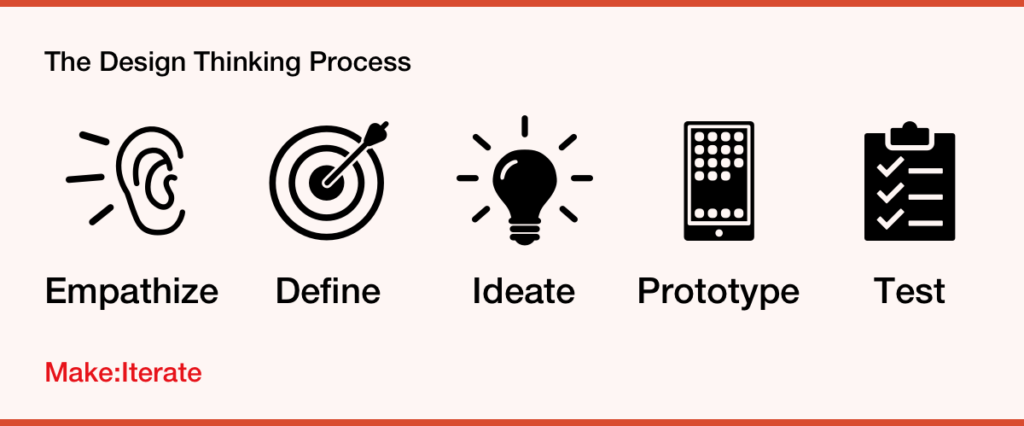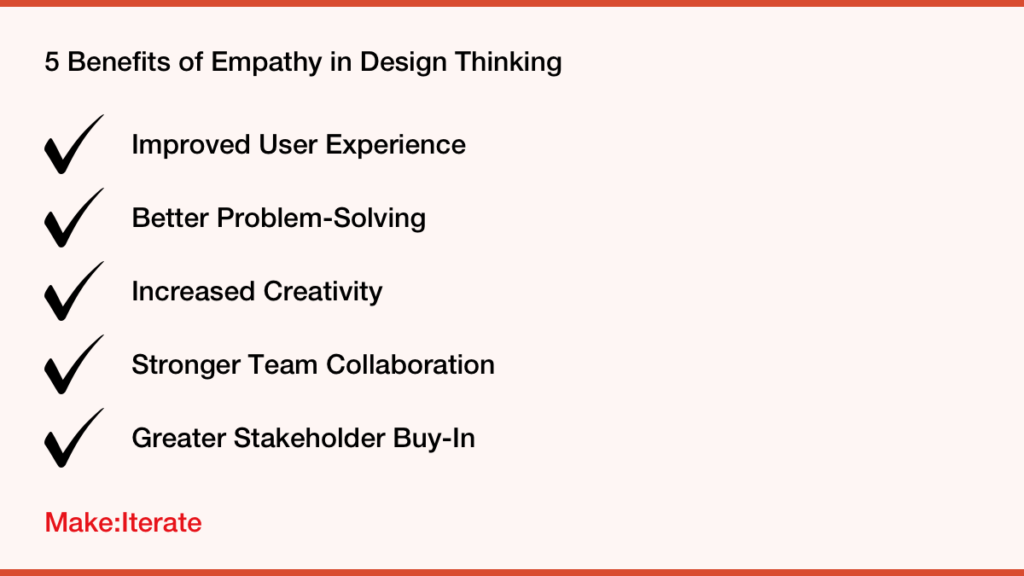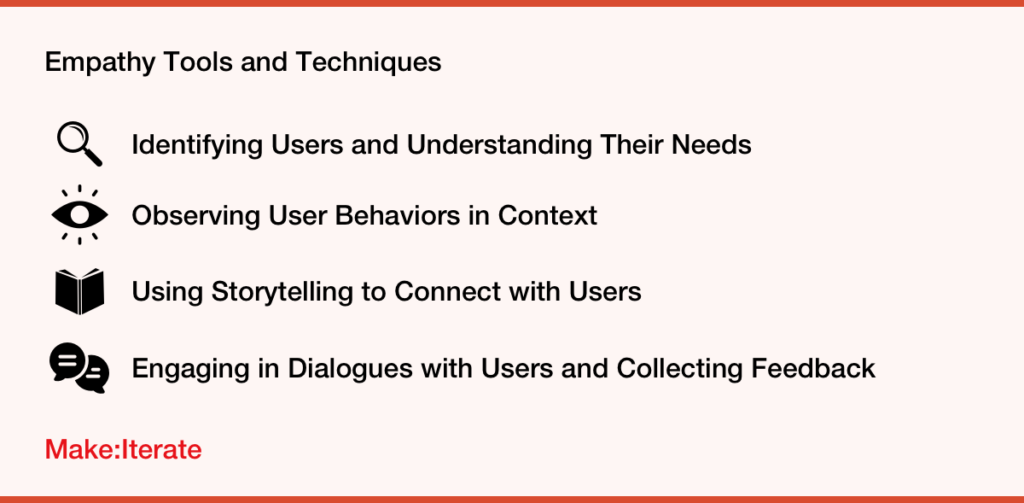Empathy is our ability to understand the needs of another person.
It’s the first step in the design thinking process, and It’s a key consideration at every stage as it allows us to solve customer’s problems in a meaningful way.
In this article, we’ll explore the role of empathy in design thinking and give some practical tips for increasing empathy in your own design process.

The Role of Empathy in Design Thinking
Empathy differentiates the design thinking methodology from traditional problem-solving approaches and allows us to create truly human-centered solutions.
It’s crucial because it allows us to understand and solve complex, “wicked” problems in a more holistic and human-centered way.
Unlike traditional design methods, which often take an analytical approach to designing solutions, design thinking puts the needs and desires of the end user at the center of the design process.
Design thinking is a problem-solving approach that puts the needs of the end user at the center and relies on empathy to create meaningful solutions.
By actively seeking to understand and empathize with the people we are designing for, we can create solutions that truly meet their needs and address their challenges in a meaningful way.
Building empathy is particularly important when dealing with complex problems, which often have many different stakeholders and factors at play.
By using empathy to understand the perspectives and needs of all parties involved, we can more accurately define the problem and create solutions with a higher chance of success.
Empathy is particularly crucial when designing for vulnerable or disadvantaged groups, as it allows us to build trust and establish a strong connection with the people we’re designing for.

5 Benefits of Empathy in Design Thinking
1. Improved User Experience
By understanding and empathizing with the needs and emotions of users, designers can create products and experiences that are more intuitive and satisfying to use and more effective in meeting the needs of the people who will be using them. This requires designers to take a deep dive into the user’s perspective, actively listening to their needs and desires and seeking to understand their motivations and challenges.
2. Better Problem-Solving
The empathetic approach helps us solve problems by allowing us to understand the perspective and needs of the people who are experiencing the problem. By actively seeking to understand and empathize with the people we are designing for, we can gain a deeper insight into the root causes of the problem and the potential barriers to adoption or satisfaction.
3. Increased Creativity
User empathy helps designers think outside the box and come up with creative solutions that they may not have considered otherwise. It allows designers to see the problem from multiple perspectives as they consider different user groups’ goals. Empathy can also help designers to challenge their own assumptions and biases, encouraging them to think more critically and creatively about the problem at hand.
4. Stronger Team Collaboration
By empathizing with the user, team members can better understand their needs and prioritize accordingly. This creates a shared understanding and vision for the project, which helps to align everyone’s efforts and focus their energy on creating solutions that have been validated as desirable. Empathy can foster cross-functional collaboration and break down silos, as team members from different disciplines and backgrounds come together to co-create solutions based on evidence from user research.
5. Greater Stakeholder Buy-In
Empathy helps designers to understand and address the needs and concerns of all stakeholders, not just the end user. This includes everyone from the client or sponsor, to the engineers or developers who will be implementing the design, to the broader community or ecosystem in which the design will be used. This helps the designer get buy-in from stakeholders by carefully considering their needs and factoring them into the design strategy.
How Empathy Fits into the Design Thinking Process
Empathy is a fundamental part of the design thinking process, and it plays a critical role in helping designers understand the end user’s needs and pain points.
In the empathize phase of the design process, designers seek to understand the user’s needs and pain points.
The empathize phase of the design process is about actively seeking to understand the user, which can involve a range of user research and testing methods such as contextual inquiry, user interviews, and usability tests.
After the empathize phase, designers move on to the define phase, where they use the insights gained from the empathize phase to define the problem and lay the foundation to start identifying potential solutions.

How to Practice Empathy in Design Thinking
Observe Users and Be Curious About Their Behavior
Designers need to be curious in order to gain a deeper understanding of user needs and challenges.
This requires them to stay open-minded and explore new ideas rather than simply relying on their assumptions or biases.
One way designers can gain a deeper understanding of the user is by observing them in their natural environment and paying attention to their behaviors.
By observing users, designers can identify patterns and trends that can inform the design process and help ensure that the solutions created are tailored to the user’s needs.
Ask Open-Ended Questions and Practice Active Listening
Asking open-ended questions and practicing active listening are important techniques in the design thinking process.
They help designers gain a deeper understanding of the user’s needs and challenges.
Open-ended questions and active listening are important techniques in the design thinking process as they help designers to gain a deeper understanding of the user’s needs and challenges.
Open-ended questions are important when interviewing customers because they allow the user to share their thoughts and feelings in their own words, rather than being limited by closed-ended or leading questions.
This can help designers to gain a more accurate and nuanced understanding of the user’s perspective and to identify patterns and trends that might not be apparent through more structured or directive questioning.
Put Yourself in the User’s Shoes to Understand the Lived Experience
A lived experience is the unique and personal perspective that an individual has of a particular event or situation.
It is important that we hear from people about their lived experiences because it allows us to understand the context, emotions, and challenges they faced.
A lived experience is an individual’s perspective of a particular event or situation.
By putting ourselves in the shoes of our users, we can gain a deeper understanding of their needs and motivations and be able to design more effective and relevant solutions.
Some tips on putting ourselves in our users’ shoes include: actively listening to their stories and perspectives, asking open-ended questions to understand their experiences better, and trying to see things from their perspective.
Use Empathy Maps, Personas, and Journey Maps
Empathy mapping, personas, and journey maps are all artifacts that can be used to build empathy for our target users in the UX design and design thinking process.
These artifacts allow us to capture and synthesize information about our users, such as their goals, pain points, emotions, and behaviors.
As well as helping us build empathy for our users, these artifacts are beneficial for sharing our learnings and creating a shared understanding of empathy with our team and stakeholders.
They provide a visual and tangible representation of our users that can be used to communicate and align on the design direction.
Practical Ways to Gain Empathy in Design Thinking
Interviews and Observations
Interviews and observations are key tools for gaining empathy in design thinking because they allow us to directly listen to and observe users in their own context.
By conducting a user interview, we can learn firsthand about users’ needs, motivations, behaviors, and challenges.
Interviews and observations are key tools for understanding users to inform design.
Some tools and techniques for interviewing and observing users include conducting one-on-one interviews, focus groups, usability testing, and field observations.
To plan and prepare for interviews and observations, it is important to determine the goals and objectives of the research, identify the participants and recruit them, create a schedule and plan for the sessions, and develop a set of questions or tasks to guide the research.
It’s also helpful to test and refine the research plan with a small group of users before conducting the full study.
Rapid Prototyping and Testing with Users
Rapid prototyping is the process of quickly creating a physical or digital representation of a design idea, in order to test and evaluate it with users.
It’s an important part of the design thinking process because it allows us to quickly explore and iterate on ideas, and gather feedback from users in order to improve the design.
Rapid prototyping helps us explore the problem and design better solutions by testing and validating our assumptions about the user and the solution.
Rapid prototyping is the process of quickly creating a physical or digital representation of a design idea, in order to test and evaluate it with users.
To get started with rapid prototyping, it’s important to first identify the goals and objectives of the prototype, as well as the target users and their needs.
Next, we can sketch out rough ideas and select the most promising ones to develop further. From there, we can create a prototype using a variety of materials and techniques, depending on the goals and resources available.
Finally, we can test the prototype with users to gather feedback and iterate on the design.
Empathy Maps, Storyboards, User Journeys, and Personas
UX and design thinking artifacts, such as empathy maps, storyboards, user journeys, and user personas, are important tools for helping us to build empathy with our users and share that empathy with our product design team and stakeholders.
These artifacts allow us to capture and synthesize information about our users, such as their goals, pain points, emotions, and behaviors.
UX and design thinking artifacts help us build empathy with users and share that empathy with our team and stakeholders.
By creating these artifacts, we can better understand our users’ needs and challenges, and design solutions that are more relevant and effective for them.
Some types of empathic design artifacts that we might use throughout the design thinking process include: empathy maps, which help us to understand users’ feelings and needs; storyboards, which illustrate a customer experience in a narrative format; user journeys, which show the steps a user takes to accomplish a task; and a persona, which represent a user segment in a fictionalized, but realistic way.
To decide which artifacts to create, consider the project’s goals, your users’ needs, and the resources available.
Key Takeaways
- Empathy is crucial to design thinking because it allows us to understand and solve complex, “wicked” problems in a more holistic and human-centered way.
- The benefits of empathy in design thinking include improved user experience, better problem solving, increased creativity, stronger team collaboration, greater stakeholder buy-in, enhanced customer relationships, and increased market success.
- Empathy is a fundamental part of the design thinking process and it plays a critical role in helping designers understand the end user’s needs and pain points.
- To practice empathy in design thinking observe users and be curious about their behavior; ask open-ended questions; put yourself into the shoes of your target user; use empathy maps personas storyboards etc.; conduct interviews or observations; practice active listening.


